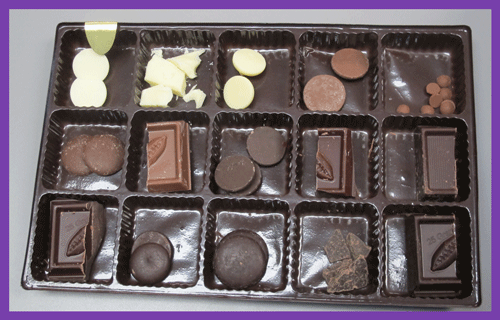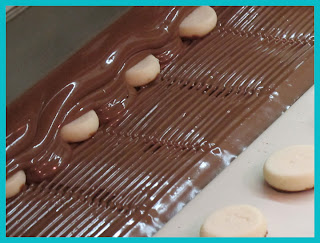|
|
Posted By RCI,
Tuesday, November 18, 2014
Updated: Wednesday, April 29, 2020
|
It is almost the season for making life-size chocolate Santas. Ok, we realize they aren’t really life-size but some of the pretty large ones could definitely be life-size for a child!
Either way, this week on the blog we have a small but useful tip to help you evenly distribute the chocolate in your life-size moulded Santa Claus. Since these huge moulds aren’t likely to fit on a mould spinner, most candy makers seem to have a special way of spinning and flipping the moulds to be sure the chocolate doesn’t all gather on one side as it hardens. To help with this process our tip is to make a rule for your staff that each time they walk by the mould they need to flip it.
Be sure every staff member knows and understands the reason for this rule is to evenly spread the chocolate inside the mould to help ensure they’ll follow it. Additionally, it would be wise to assign a staff member to be in charge of ensuring the mould is flipped on a regular schedule. For example, if it needs to be flipped every five minutes and no one walks by for 10 minutes, this staff person would be the one to flip it at the five minute mark. It would probably be helpful to have a pen and paper chart nearby for staff to initial and write the time when they flip the mould.
By involving all staff to flip your extra large moulds you’ll be creating a team environment where everyone pitches in, in addition to adding an element of quality control,
P.S. This tip came from our Mechanics of Chocolate Moulding education course held last fall. Attend RCI’s next education course, Chocolate Boot Camp®, by registering online today at retailconfectioners.org/bootcamp.
Tags:
Candy Making
Chocolate
Holidays
Moulds
Quality Control
Seasonal
Permalink
| Comments (0)
|
|
|
Posted By RCI,
Tuesday, September 23, 2014
Updated: Thursday, April 30, 2020
|
 |
| Tasting Tray from RCI's Chocolate Boot Camp |
As you know, quality control requires that you taste test your products, including the chocolate ingredients you use. Therefore, today’s tip is a quick one that will help you get the most accurate flavor when doing a chocolate tasting.
The tip? Use room temperature water to cleanse your palate between tastings rather than cold water. Because cold hardens the fats in your mouth it affects tasting. However, room temperature water is one way to help ensure that you taste the full and accurate flavor of the chocolate.
P.S. Today’s tip was from RCI’s Chocolate Boot Camp education course. Registration for our 2015 session recently opened online. Visit retailconfectioners.org/bootcamp for more information.
Tags:
Candy Making
Chocolate
GMP's
Quality Control
Permalink
| Comments (0)
|
|
|
Posted By RCI,
Tuesday, August 12, 2014
Updated: Thursday, April 30, 2020
|
|
Permalink
| Comments (0)
|
|
|
Posted By RCI,
Tuesday, July 15, 2014
Updated: Thursday, April 30, 2020
|
Truffles are a consistent customer favorite but their delicious centers also have a high water activity which means the shelf life is limited. This week’s blog tip is to consider ideas to decrease water activity and therefore extend the shelf life of your truffles.
One idea is to use invertase, an enzyme derived from yeast, as an ingredient to bring down water activity in your truffle centers. Additionally, syrups such as honey will work similarly. Or you may also use potassium sorbate. Talk to your ingredients suppliers to determine the right amount to use for your specific truffle recipes.
Do note that if you claim that your products are all natural, you should pay close attention to how you choose to extend shelf life of your products. See this story on a bagel company who received a warning from the FDA for labeling their bagel as all natural because their blueberries contained potassium sorbate.
P.S. You’re invited to join RCI at our Fall Regional Conference next month! We’ll be connecting in Las Vegas August 25-27 and you can register online now at retailconfectioners.org/fall. Register by July 25 to save $100 on full registration!
Tags:
Candy Making
GMP's
Natural
Quality Control
Truffles
Permalink
| Comments (0)
|
|
|
Posted By RCI,
Tuesday, June 10, 2014
Updated: Thursday, April 30, 2020
|
This week’s tip is quick and easy and may save yourself a headache as you temper chocolate in small batch tempering machines.
Are you using chocolate wafers as seed for your tempering unit? Before putting them in the feed of the tempering machine, quickly (don’t overheat!) use a heat gun on them to form one large clump or block of wafers. By doing this, you will help keep the wafers from sneaking through the blade and over-tempering your chocolate.
See? Quick and easy!
This week’s tip was shared during our Chocolate Boot Camp education course. RCI will be hosting a Creams, Fondants & Fudges course August 5-7 in Dayton, Ohio. Visit retailconfectioners.org/events to stay up-to-date with RCI's education course offerings in the coming year.
Tags:
Candy Making
Quality Control
Permalink
| Comments (0)
|
|
|
Posted By RCI,
Tuesday, May 13, 2014
Updated: Thursday, April 30, 2020
|
You’ve made a delicious product covered in chocolate and now it is time to package it. Have you considered how the temperature of the packaging room or area will affect your product?
This week’s tip is to control the temperature of your packaging room or area in order to protect the integrity of your products. Oftentimes the focus of room temperature is on the cooking or kitchen area but the temperature and relative humidity of the packaging area is important as well. For example, conditions with high humidity will lead to moisture condensation which will eventually result in sugar bloom on the product’s surface. Additionally, conditions that are too warm could melt your products.
Confectionery experts recommend that the packaging area be maintained at 65° to 70°F with a relative humidity of maximum 65 percent. To help with control, install a thermometer that measures both temperature and relative humidity and assign an employee to check the measurements on a regular schedule.
Temperature control is one of many factors and variables that should be considered as you prepare product for customer distribution. The decisions you make about these items can help to prolong the beauty and shelf life of your confections.
Tags:
Candy Making
GMP's
Packaging
Quality Control
Permalink
| Comments (0)
|
|
|
Posted By RCI,
Tuesday, March 11, 2014
Updated: Thursday, April 30, 2020
|
This week’s tip will help keep you on track for quality control. Take a sample of every product, label appropriately (lot code, date, etc.) and freeze it for a set amount of time. Then, if a customer calls and complains for any reason about your products, you have a frame of reference to be able to say this is the condition the product was in when it left our facility.
One RCI member does this and has a ziplock bag for each day. The company keeps the product for four months and then discards it. Regardless of how long you choose to keep the product, be sure that you have a system for organizing it within your freezer so that you can easily find the items and then also easily discard of them when the time period for keeping them has passed.
P.S. This week’s tip is from our Chocolate Boot Camp education course. Learn more about education courses offered by Retail Confectioners International at www.retailconfectioners.org/events.
Tags:
Candy Making
GMP's
Quality Control
Permalink
| Comments (0)
|
|
|
Posted By RCI,
Tuesday, February 11, 2014
Updated: Thursday, April 30, 2020
|
In honor of Chocolate Mint Day next week (February 19), this week’s tip reminds you to have all mint-flavored treats stored separately from other confections.
While mint is refreshingly cool and goes great with chocolate, it is also an overwhelming flavor that can seep into the flavor of your other candies and chocolates. Therefore, it is recommended to store your mint flavoring as well as products containing mint separate from other goods. Some candy makers make a lot of mint chocolates and find that a completely separate “mint room” is necessary but if that is not the case for you, storing them in sealed containers will at least seal in the flavor.
Do you have other ways for storing your mint flavored products? Please share them in the comments below!
We hope you have a Happy Valentine's Day!
Tags:
Candy Making
Cleaning
Organizing
Packaging
Quality Control
Permalink
| Comments (0)
|
|
|
Posted By RCI,
Tuesday, January 14, 2014
Updated: Thursday, April 30, 2020
|
You’re very diligent to clean fingerprints and smudges on the front of your candy cases but have you given thought to how often you clean the inside of your cases and other fixtures? This week’s tip is to remind you that cleaning behind fixtures is just as important as cleaning the front of cases and fixtures.
As you know, presentation matters when it comes to displaying your beautiful chocolates and candies in the store. You may not think the inside of your cases would get dirty but dust could collect there in addition to smudges from moving product in and out of the case. A pristine case will help increase the perceived value of your products so take the time to ensure it is clean both inside and out.
How often should you clean the inside of your cases? That depends on how often the doors to the cases are opened, when product is moved, etc. Whatever you decide, be sure it is added to the cleaning schedule so employees don’t overlook this important task.
P.S. This tip was from the GMP series featured in the Jan/Feb/Mar 2012 issue of Kettle Talk. RCI members may access the entire series by signing in to the RCI website and viewing Kettle Talk issues from 2012.
Tags:
Cleaning
GMP's
Merchandising
Quality Control
Permalink
| Comments (0)
|
|
|
Posted By RCI,
Tuesday, December 3, 2013
Updated: Thursday, April 30, 2020
|
Out of respect for confectioners’ busy holiday schedules, December’s blog tips will be quick tips.
Have you had issues with air pockets showing up on your enrobed confections? This week’s tip is to be sure the chocolate curtain on your enrober is as close as possible to the centers or confections being enrobed to avoid air pockets. If the curtain is too far above your centers, then there is more of an opportunity for air pockets to form.
This tip was shared at our 2013 Chocolate Boot Camp education course. Learn more about this hands-on course for confectioners at retailconfectioners.org/bootcamp.
Tags:
Candy Making
Photos
Quality Control
Permalink
| Comments (0)
|










